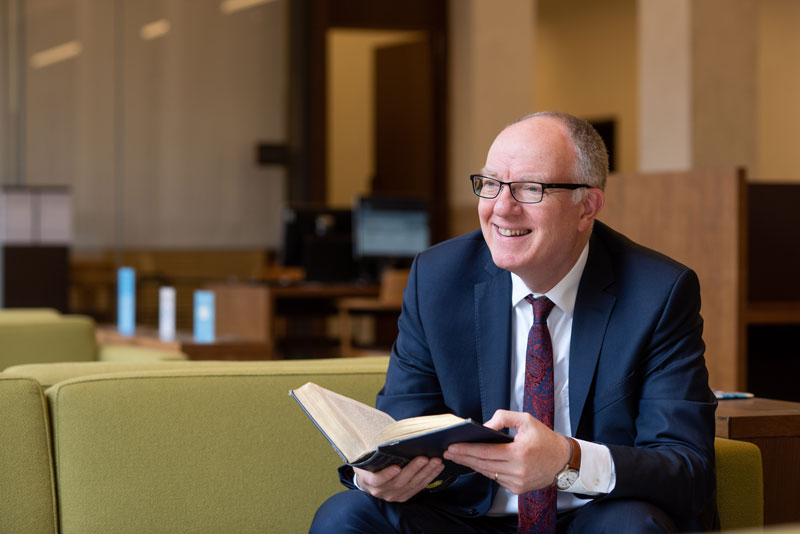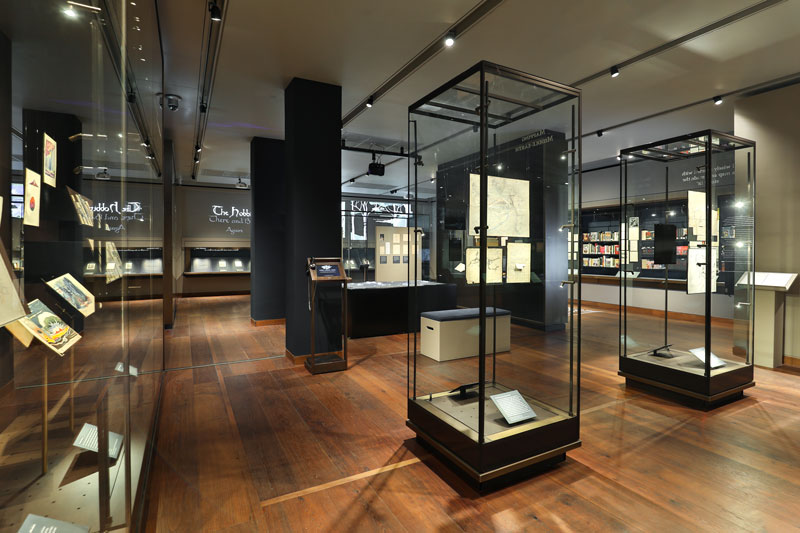Building the library of the future
Thanks to donor support, an unloved historic building has been transformed into a 21st-century research facility and visitor space.
Richard Ovenden’s first day as Keeper of Special Collections was a memorable one; he had been in the job for just over half an hour before he became aware of a problem unfolding in the stacks. ‘The air-conditioning system operating in part of the New Bodleian was spewing out soot onto the collections,’ he recalls. ‘It was clear right then and there that there were major problems with the infrastructure of the building, and that it needed to change.’
Constructed during the 1930s and 40s on the corner of Broad Street and Parks Road, the New Bodleian Library had long been a cause of consternation among those who worked within it. As well as struggling with ‘the basic nuts and bolts of preserving the collections’, it offered limited opportunities for research, and none at all for public engagement. It was, in short, in urgent need of modernisation.
Fast forward to the present day, and the building – which closed in 2011 for a radical, multi-year transformation – is now a model for research libraries worldwide. It boasts state-of-the-art facilities for conservation and research, dedicated spaces for scholarship and three floors of secure underground storage for the Bodleian’s special collections. The ground floor is open to the public now too, with exhibition galleries, a 44-foot atrium, a café and a shop inviting people to venture inside.
 Bodley’s Librarian Richard Ovenden, OBE. Photo by John Cairns
Bodley’s Librarian Richard Ovenden, OBE. Photo by John Cairns
Of the £76 million required for the renovation, a remarkable £39.1 million was contributed by donors. The first gift to the project – £5 million from Julian Blackwell – was quickly followed by £25 million from the Garfield Weston Foundation, in recognition of which the building was renamed the Weston Library. ‘Donors saw the opportunity that the project offered for transforming the Bodleian and really got behind it,’ notes Richard, now Bodley’s Librarian.
The impact that the building has had on the institution since reopening cannot be overstated. In providing the space and facilities that were so sorely needed, the Weston Library has empowered and inspired those within it to think and work on a much grander scale – a response that has been more than matched by the Bodleian’s supporters. ‘It’s had a huge impact on our ability to raise funds for our work,’ says Richard. ‘We see this on the conservation side, on the research and education side and on the public engagement side too.’
‘ We’re not just a university library, we’re an institution that plays an absolutely fundamental part in British and world cultural life’
One area where this impact is particularly visible is the library’s exhibitions programme. Before the Weston opened its doors, there was just a single place where members of the public could see a rare book or ancient manuscript from the library’s collections: a small gallery in Old Schools Quad. Today they can choose between two purpose-built galleries in the Weston Library, each with their own distinct look and feel.
As well as funding the galleries themselves, philanthropy also powers the programme that fills them, explains Madeline Slaven, Head of Exhibitions: ‘Donor support allows us to think much bigger. It means we can put marketing in place, consider things like external loans, and collaborate with and commission artists, all of which makes a difference to the way people experience an exhibition.’
For the Bodleian’s recent Tolkien exhibition, for example, donations enabled Madeline and her team to work with Factum Arte, an internationally renowned group of artists and digital technicians. ‘They created an immersive three-dimensional map of Middle-earth,’ she says. ‘It was mesmerising, and augmented the actual display of items in cases. It was a huge hit with visitors.’
 Inside the Tolkien: Maker of Middle-earth exhibition. Photo by Ian Wallman / Bodleian Libraries
Inside the Tolkien: Maker of Middle-earth exhibition. Photo by Ian Wallman / Bodleian Libraries
In the space of just four years, the Weston Library has hosted 14 large exhibitions and welcomed over 3 million visitors through its doors. ‘This space has allowed us to interact more with our audiences, and through that, understand more about the display of our collections and about the collections themselves,’ Madeline says. ‘If we have the support, there’s really no limit to what we can achieve. There’s just so much potential.’
This potential is clearly not lost on donors, whose generosity has touched everything from conservation to acquisitions, digitisation to education. For Richard, however, the biggest surprise of all has been the endowment, which has more than doubled since 2014. ‘I had a target that it would take us ten years to do that, so the fact that we’ve done it in half that time is absolutely extraordinary.’
Today, the future of the library looks bright. ‘The scale and speed at which we’ve been able to move has been purely because of the philanthropic support we’ve received,’ beams Richard. ‘We feel very fortunate indeed.’
SUPPORT THE BODLEIAN